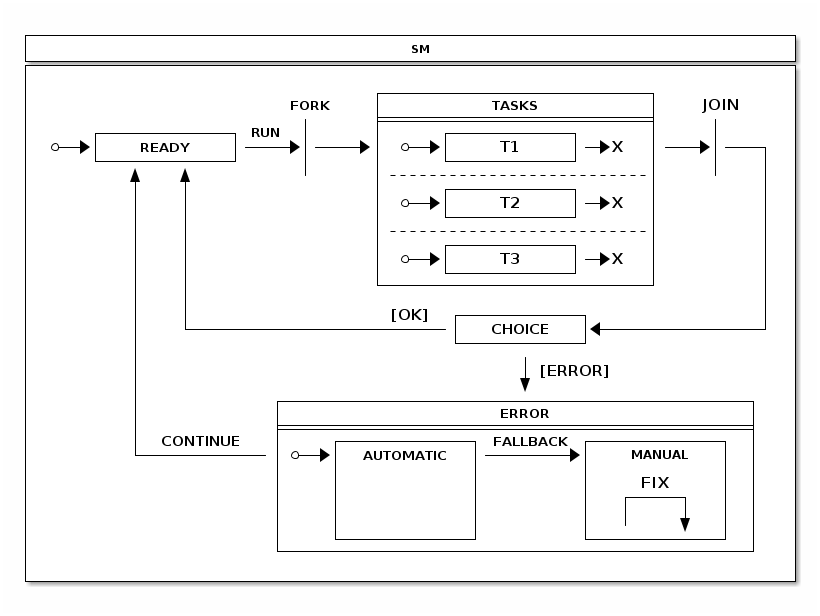Tasks is a sample demonstrating a parallel task handling within a regions and additionally adds an error handling to either automatically or manually fixing task problems before continuing back to a state where tasks can be run again.

On a high level what happens in this state machine is:
- We’re always trying to get into READY state so that we can use event RUN to execute tasks.
- TASKS state which is composed with 3 independent regions has been put in a middle of FORK and JOIN states which will cause regions to go into its initial states and to be joined by end states.
- From JOIN state we go automatically into a CHOICE state which checks existence of error flags in extended state variables. Tasks can set these flags and it gives CHOICE state a possibility to go into ERROR state where errors can be handled either automatically or manually.
- AUTOMATIC state in ERROR can try to automatically fix error and goes back to READY if it succeed to do so. If error is something what can’t be handled automatically, user intervention is needed and machine is put into MANUAL state via FALLBACK event.
States.
public enum States {
READY,
FORK, JOIN, CHOICE,
TASKS, T1, T1E, T2, T2E, T3, T3E,
ERROR, AUTOMATIC, MANUAL
}
Events.
public enum Events {
RUN, FALLBACK, CONTINUE, FIX;
}
Configuration - states.
@Override public void configure(StateMachineStateConfigurer<States, Events> states) throws Exception { states .withStates() .initial(States.READY) .fork(States.FORK) .state(States.TASKS) .join(States.JOIN) .choice(States.CHOICE) .state(States.ERROR) .and() .withStates() .parent(States.TASKS) .initial(States.T1) .end(States.T1E) .and() .withStates() .parent(States.TASKS) .initial(States.T2) .end(States.T2E) .and() .withStates() .parent(States.TASKS) .initial(States.T3) .end(States.T3E) .and() .withStates() .parent(States.ERROR) .initial(States.AUTOMATIC) .state(States.AUTOMATIC, automaticAction(), null) .state(States.MANUAL); }
Configuration - transitions.
@Override public void configure(StateMachineTransitionConfigurer<States, Events> transitions) throws Exception { transitions .withExternal() .source(States.READY).target(States.FORK) .event(Events.RUN) .and() .withFork() .source(States.FORK).target(States.TASKS) .and() .withExternal() .source(States.T1).target(States.T1E) .and() .withExternal() .source(States.T2).target(States.T2E) .and() .withExternal() .source(States.T3).target(States.T3E) .and() .withJoin() .source(States.TASKS).target(States.JOIN) .and() .withExternal() .source(States.JOIN).target(States.CHOICE) .and() .withChoice() .source(States.CHOICE) .first(States.ERROR, tasksChoiceGuard()) .last(States.READY) .and() .withExternal() .source(States.ERROR).target(States.READY) .event(Events.CONTINUE) .and() .withExternal() .source(States.AUTOMATIC).target(States.MANUAL) .event(Events.FALLBACK) .and() .withInternal() .source(States.MANUAL) .action(fixAction()) .event(Events.FIX); }
Guard below is guarding choice entry into a ERROR state and needs to return TRUE if error has happened. For this guard simply checks that all extended state variables(T1, T2 and T3) are TRUE.
@Bean public Guard<States, Events> tasksChoiceGuard() { return new Guard<States, Events>() { @Override public boolean evaluate(StateContext<States, Events> context) { Map<Object, Object> variables = context.getExtendedState().getVariables(); return !(ObjectUtils.nullSafeEquals(variables.get("T1"), true) && ObjectUtils.nullSafeEquals(variables.get("T2"), true) && ObjectUtils.nullSafeEquals(variables.get("T3"), true)); } }; }
Actions below will simply send event to a state machine to request next step which would be either fallback or continue back to ready.
@Bean public Action<States, Events> automaticAction() { return new Action<States, Events>() { @Override public void execute(StateContext<States, Events> context) { Map<Object, Object> variables = context.getExtendedState().getVariables(); if (ObjectUtils.nullSafeEquals(variables.get("T1"), true) && ObjectUtils.nullSafeEquals(variables.get("T2"), true) && ObjectUtils.nullSafeEquals(variables.get("T3"), true)) { context.getStateMachine().sendEvent(Events.CONTINUE); } else { context.getStateMachine().sendEvent(Events.FALLBACK); } } }; } @Bean public Action<States, Events> fixAction() { return new Action<States, Events>() { @Override public void execute(StateContext<States, Events> context) { Map<Object, Object> variables = context.getExtendedState().getVariables(); variables.put("T1", true); variables.put("T2", true); variables.put("T3", true); context.getStateMachine().sendEvent(Events.CONTINUE); } }; }
Currently default region execution is synchronous but it can be
changed to asynchronous by changing TaskExecutor. Task will simulate
work by sleeping 2 seconds so you’ll able to see how actions in
regions are executed parallel.
@Bean(name = StateMachineSystemConstants.TASK_EXECUTOR_BEAN_NAME) public TaskExecutor taskExecutor() { ThreadPoolTaskExecutor taskExecutor = new ThreadPoolTaskExecutor(); taskExecutor.setCorePoolSize(5); return taskExecutor; }
Let’s see an examples how this state machine actually works.
sm>sm start State machine started Entry state READY sm>tasks run Entry state TASKS run task on T3 run task on T2 run task on T1 run task on T2 done run task on T1 done run task on T3 done Entry state T2 Entry state T3 Entry state T1 Entry state T1E Entry state T2E Entry state T3E Exit state TASKS Entry state JOIN Exit state JOIN Entry state READY
In above we can execute tasks multiple times.
sm>tasks list
Tasks {T1=true, T3=true, T2=true}
sm>tasks fail T1
sm>tasks list
Tasks {T1=false, T3=true, T2=true}
sm>tasks run
Entry state TASKS
run task on T1
run task on T3
run task on T2
run task on T1 done
run task on T3 done
run task on T2 done
Entry state T1
Entry state T3
Entry state T2
Entry state T1E
Entry state T2E
Entry state T3E
Exit state TASKS
Entry state JOIN
Exit state JOIN
Entry state ERROR
Entry state AUTOMATIC
Exit state AUTOMATIC
Exit state ERROR
Entry state READY
In above, if we simulate failure for task T1, it is fixed automatically.
sm>tasks list
Tasks {T1=true, T3=true, T2=true}
sm>tasks fail T2
sm>tasks run
Entry state TASKS
run task on T2
run task on T1
run task on T3
run task on T2 done
run task on T1 done
run task on T3 done
Entry state T2
Entry state T1
Entry state T3
Entry state T1E
Entry state T2E
Entry state T3E
Exit state TASKS
Entry state JOIN
Exit state JOIN
Entry state ERROR
Entry state AUTOMATIC
Exit state AUTOMATIC
Entry state MANUAL
sm>tasks fix
Exit state MANUAL
Exit state ERROR
Entry state READY
In above if we simulate failure for either task T2 or T3, state machine goes to MANUAL state where problem needs to be fixed manually before we’re able to go back to READY state.